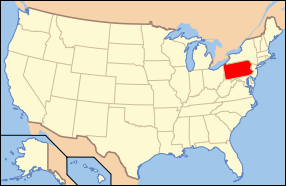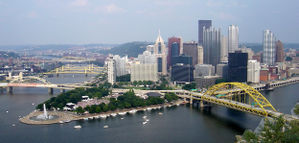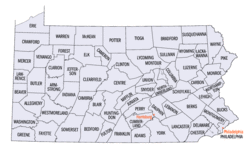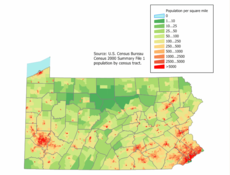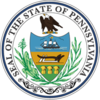|
|
||||||||||||||||||||||||
The Commonwealth of Pennsylvania is a state in the northeastern part of the United States. One of Pennsylvania's nicknames is the Quaker State; in colonial times, it was known officially as the Quaker Province, in recognition of Quaker William Penn's First Frame of Government constitution for Pennsylvania that guaranteed liberty of conscience. Penn knew of the hostility Quakers faced when they opposed rituals, oaths, violence, and ostentatious frippery. Pennsylvania has also been known as the Keystone State since 1802, based in part upon its central location among the original Thirteen Colonies forming the United States. It was also a keystone state economically, having both the industry common to the North, making such wares as Conestoga wagons and rifles, and the agriculture common to the South, producing feed, fiber, food, and tobacco. Pennsylvania has 51 miles (82 km) of coastline along Lake Erie and 57 miles (92 km) of shoreline along the Delaware Estuary. Philadelphia is Pennsylvania's largest city and is home to a major seaport and shipyards on the Delaware River.
The original southern boundary of Pennsylvania was supposed to be at 40° North latitude, but as a result of a bad faith compromise by Lord Baltimore during Cresap's War, the king's courts moved the boundary 20 miles south to 39° 43' N. The city of Philadelphia, at 40°0'N 75°8'W, would have been split in half by the original boundary. While he was a captive Cresap, a Marylander, was paraded through Philadelphia, he taunted the officers by announcing that Philadelphia was one of the prettiest towns in Maryland. History Before the state existed, the area was home to the Delaware (also known as Lenni Lenape), Susquehannock, Iroquois, Eriez, Shawnee, and other Native American tribes. In 1681, Charles II granted a land charter to William Penn, to repay a large debt owed to William's father, Admiral Penn. This was one of the largest land grants to an individual in history. The land included present-day Delaware and Pennsylvania. It was called Pennsylvania, meaning "Penn's Woods", in honor of Admiral Penn. Penn established a government with two innovations that were much copied in the New World: the county commission, and freedom of religious conviction. Writer Murray Rothbard in his four-volume history of the U.S., Conceived in Liberty, refers to the years of 1681–90 as "Pennsylvania's Anarchist Experiment." Between 1723 until it was shut down by Parliament with the Currency Act of 1764, the Pennsylvania Colony made its own paper money, generally called Colonial Scrip and it is generally regarded as the most successful currency experiment by any government that ever existed. The Colony issued "bills of credit" which were as good as gold or silver coins because of their legal tender status. Since they were issued by the government and not a banking institution, it was an interest-free proposition, largely defraying the expense of the government and therefore taxation of the people. It also promoted generaly employment and prosperity. Benjamin Franklin had a hand in creating this currency, of which he said its utility was never to be disputed and it also received the high praise of Adam Smith. After the Stamp Act Congress of 1765, Delegate John Dickinson of Philadelphia, Pennsylvania wrote the Declaration of Rights and Grievances. The Congress was the first meeting of the thirteen colonies, called at the request of the Massachusetts Assembly, but only nine colonies sent delegates. Dickinson then wrote Letters from a Farmer in Pennsylvania, To the Inhabitants of the British Colonies, which were published in the Pennsylvania Chronicle between December 2, 1767, and February 15, 1768. When the Founding Fathers of the United States were to convene in Philadelphia in 1774, 12 of the 13 colonies sent representatives to the First Continental Congress. The First Continental Congress drew up and signed the Declaration of Independence in Philadelphia, but when that city was captured by the British, the Continental Congress escaped westward, meeting at the Lancaster courthouse on Saturday, September 27, 1777, and then to York. There they drew up the Articles of Confederation that formed the independent colonies into a new nation. Later, the Constitution was written, and Philadelphia was once again chosen to be cradle to the new American Nation. Pennsylvania became the second state to ratify the U.S. Constitution on December 12, 1787, five days after Delaware became the first. For half a century, the state legislature met at various places in the general Philadelphia area before starting to meet regularly in Independence Hall in Philadelphia for 63 years. But it needed a more central location, as for example the Paxton Boys massacres of 1763 had made them aware. So, in 1799 the legislature moved to the Lancaster Courthouse, and finally in 1812 to Harrisburg. The legislature met in the old Dauphin County Court House until December 1821, when the Redbrick Capitol was finished. It burned down in 1897, presumably due to a faulty flue. The legislature met at Grace Methodist Church on State Street (still standing), until the present capitol was finished in 1907. The new state Capitol drew rave reviews. Its dome was inspired by the domes of St. Peter's Basilica in Rome and the United States Capitol. President Theodore Roosevelt called it the "the most beautiful state Capitol in the nation", and said "It's the handsomest building I ever saw" at the dedication. In 1989, the New York Times praised it as "grand, even awesome at moments, but it is also a working building, accessible to citizens ... a building that connects with the reality of daily life." James Buchanan, of Lancaster, Pennsylvania, was the only bachelor President of the United States. The Battle of Gettysburg — the major turning point of the Civil War — took place near Gettysburg. |
|
||||||||||||||||||||||||


